Human mission to Mars
A human mission to Mars has been the subject of science fiction, aerospace engineering and scientific proposals since the 20th century. Plans include landing on Mars for exploration at a minimum, with the possibility of sending settlers and terraforming the planet or exploring its moons Phobos and Deimos also considered.
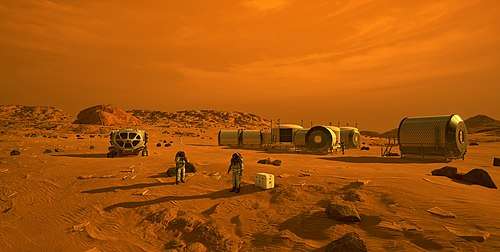
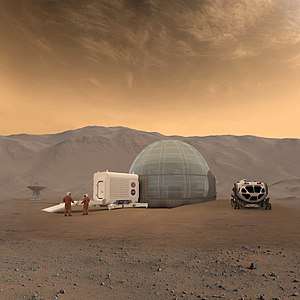
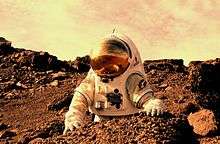
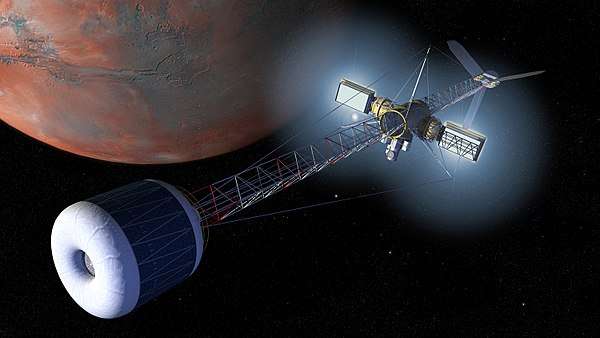
The exploration of Mars has been a goal of national space programs for decades. Conceptual work for missions that would involve human explorers has been ongoing since the 1950s, with planned missions typically being stated as taking place anywhere between 10 and 30 years from the time they are drafted.[1] The list of crewed Mars mission plans shows the various mission proposals that have been put forth by multiple organizations and space agencies in this field of space exploration. Plans have varied from scientific expeditions, in which a small group (between two and eight astronauts) would visit Mars for a period of a few weeks or year, to the permanent colonization of Mars.
In the 2010s, numerous US, European, and Asian agencies were developing proposals for human missions to Mars. In fiction, Mars is a frequent target of exploration and settlement in books, graphic novels, and films.
Travel to Mars

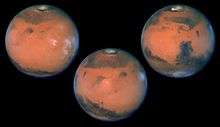
The energy needed for transfer between planetary orbits, or "Delta-v", is lowest at intervals fixed by the synodic period. For Earth / Mars trips, this is every 26 months (2 years and 2 months), so missions are typically planned to coincide with one of these launch periods. Due to the eccentricity of Mars' orbit, the energy needed in the low-energy periods varies on roughly a 15-year cycle[2] with the easiest periods needing only half the energy of the peaks.[3] In the 20th century, there was a minimum in the 1969 and 1971 launch periods and another low in 1986 and 1988, then the cycle repeated.[2] The next low-energy launch period occurs in 2033.[4]
Several types of mission plans have been proposed, including opposition class and conjunction class[3] or the Crocco flyby.[5] The lowest energy transfer to Mars is a Hohmann transfer orbit, which would involve an approximately 9 month travel time from Earth to Mars, about five hundred days at Mars to wait for the transfer window to Earth, and a travel time of about 9 months to return to Earth.[6][7]
Shorter Mars mission plans have round-trip flight times of 400 to 450 days,[8] but would require significantly higher energy. A fast Mars mission of 245 days round trip could be possible with on-orbit staging.[9] In 2014 ballistic capture was proposed, which may reduce fuel cost and provide more flexible launch windows compared to the Hohmann.[10]
In the Crocco grand tour, a crewed spacecraft would get a flyby of Mars and Venus in under a year in space.[11] Some flyby mission architectures can also be extended to include a style of Mars landing with a flyby excursion lander spacecraft.[12] Proposed by R. Titus in 1966, it involved a short stay lander-ascent vehicle that would separate from a "parent" Earth-Mars transfer craft prior to its flyby of Mars. The Ascent-Descent lander would arrive sooner and either go into orbit around Mars or land, and depending on the design offer perhaps 10–30 days before it needed to launch itself back to the main transfer vehicle.[12] (see also Mars flyby).
Aerobraking at Mars was estimated in the 1980s to cut the mass of a Mars mission lifting off from Earth by half.[13] As a result, Mars missions have designed interplanetary spacecraft and landers capable of aero-braking.[13]
Landing on Mars
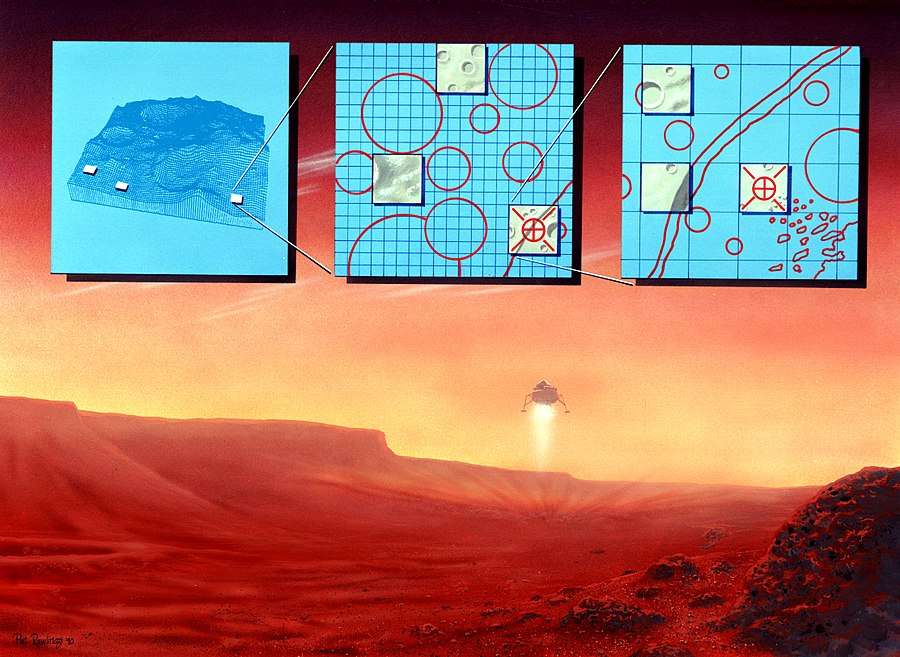
Landed spacecraft on the surface of Mars:
- Mars 3
- Viking 1 and Viking 2
- Mars Pathfinder and its Sojourner rover
- Spirit and Opportunity rovers
- Phoenix lander
- Curiosity rover
- InSight lander
- Beagle2
Orbital capture
When an expedition reaches Mars, braking is required to enter orbit. Two options are available: rockets or aerocapture. Aerocapture at Mars for human missions was studied in the 20th century.[14] In a review of 93 Mars studies, 24 used aerocapture for Mars or Earth return.[14] One of the considerations for using aerocapture on crewed missions is a limit on the maximum force experienced by the astronauts. The current scientific consensus is that 5g, or 5 times Earth gravity, is the maximum allowable acceleration.[14]
Survey work
Conducting a safe landing requires knowledge of the properties of the atmosphere, first observed by Mariner 4, and a survey of the planet to identify suitable landing sites. Major global surveys were conducted by Mariner 9 and Viking 1 and two orbiters, which supported the Viking landers. Later orbiters, such as Mars Global Surveyor, 2001 Mars Odyssey, Mars Express, and Mars Reconnaissance Orbiter, have mapped Mars in higher resolution with improved instruments. These later surveys have identified the probable locations of water, a critical resource.
Funding
The largest limiting factor for sending humans to Mars is funding. The estimated cost is roughly 500 billion U.S. dollars, though the actual costs are likely to be more.[15] Starting in the late 1950s, the early phase of space exploration was conducted as much to make a political statement as to make observations of the solar system. However, this proved to be both wasteful and unsustainable, and the current climate is one of international cooperation, with large projects such as the International Space Station and the proposed Lunar Gateway being built and launched by multiple countries.
Critics argue that the immediate benefits of establishing a human presence on Mars are outweighed by the immense cost, and that funds could be better redirected towards other programs, such as robotic exploration. Proponents of human space exploration contend that the symbolism of establishing a presence in space may garner public interest to join the cause and spark global cooperation. There are also claims that a long-term investment in space travel is necessary for humanity's survival.[15]
Medical

There are several key physical challenges for human missions to Mars:[19]
- Health threat from cosmic rays and other ionizing radiation.[20][21][22][23] In May 2013, NASA scientists reported that a possible mission to Mars may involve great radiation risk based on energetic particle radiation measured by the RAD on the Mars Science Laboratory while traveling from the Earth to Mars in 2011–2012. The calculated radiation dose was 0.66 sieverts round-trip. The agency's career radiation limit for astronauts is 1 sievert.[16][17][18][24] In mid-September 2017, NASA reported temporarily doubled radiation levels on the surface of Mars, with an aurora 25 times brighter than any observed earlier, due to a massive unexpected solar storm.[25]
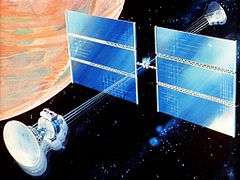
- Adverse health effects of prolonged weightlessness, including eyesight impairment.[26][27][28] (Depends on mission and spacecraft design.) In November 2019, researchers reported that astronauts experienced serious blood flow and clot problems while on board the International Space Station, based on a six-month study of 11 healthy astronauts. The results may influence long-term spaceflight, including a mission to the planet Mars, according to the researchers.[29][30]
- Psychological effects of isolation from Earth and, by extension, the lack of community due to lack of a real-time connection with Earth. (Compare Hermit.)
- Social effects of several humans living under cramped conditions for more than one Earth year, and possibly two or three years, depending on spacecraft and mission design.
- Lack of medical facilities.
- Potential failure of propulsion or life-support equipment.
Some of these issues were estimated statistically in the HUMEX study.[31] Ehlmann and others have reviewed political and economic concerns, as well as technological and biological feasibility aspects.[32] While fuel for roundtrip travel could be a challenge, methane and oxygen can be produced using Martian H2O (preferably as water ice instead of liquid water) and atmospheric CO2 with mature technology.[33]
Planetary protection
Robotic spacecraft to Mars are currently required to be sterilized. The allowable limit is 300,000 spores on the exterior of general craft, with stricter requirements for spacecraft bound to "special regions" containing water.[34][35] Otherwise there is a risk of contaminating not only the life-detection experiments but possibly the planet itself.[36]
It is impossible to sterilize human missions to this level, as humans are host to typically a hundred trillion (1014) microorganisms of thousands of species of the human microbiota, and these cannot be removed. Containment seems the only option, but it is a major challenge in the event of a hard landing (i.e. crash).[37] There have been several planetary workshops on this issue, but with no final guidelines for a way forward yet.[38] Human explorers would also be vulnerable to back contamination to Earth if they become carriers of microorganisms.[39]
Mission proposals
Over the past seven decades, a wide variety of mission architectures have been proposed or studied for human spaceflights to Mars. These have included chemical, nuclear and electric propulsion, as well as a wide variety of landing, living, and return methodologies.
20th century
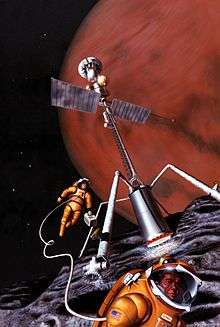
Over the last century, a number of mission concepts for such an expedition have been proposed. David Portree's history volume Humans to Mars: Fifty Years of Mission Planning, 1950–2000 discusses many of these.[2]
Wernher von Braun proposal (1947 through 1950s)
Wernher von Braun was the first person to make a detailed technical study of a Mars mission.[2][41] Details were published in his book Das Marsprojekt (1952, published in English as The Mars Project in 1962[42]) and several subsequent works.[43] Willy Ley popularized a similar mission in English in the book The Conquest of Space (1949), featuring illustrations by Chesley Bonestell. Von Braun's Mars project envisioned nearly a thousand three-stage vehicles launching from Earth to ferry parts for the Mars mission to be constructed at a space station in Earth orbit.[41][44] The mission itself featured a fleet of ten spacecraft with a combined crew of 70 heading to Mars, bringing three winged surface excursion ships that would land horizontally on the surface of Mars. (Winged landing was considered possible because at the time of his proposal, the Martian atmosphere was believed to be much denser than was later found to be the case.)
In the 1956 revised vision of the Mars Project plan, published in the book The Exploration of Mars by Wernher Von Braun and Willy Ley, the size of the mission was trimmed, requiring only 400 launches to put together two ships, still carrying a winged landing vehicle.[45] Later versions of the mission proposal, featured in the Disney "Man In Space" film series,[46] showed nuclear-powered ion-propulsion vehicles for the interplanetary cruise.
U.S. proposals (1950s to 1970s)
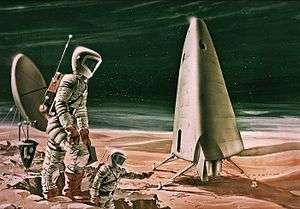
From 1957 to 1965, work was done by General Atomics on Project Orion, a proposal for a nuclear pulse propulsion spacecraft. Orion was intended to have the ability to transport extremely large payloads compared to chemical rocketry, making crewed missions to Mars and the outer planets feasible. One of the early vehicle designs was intended to send an 800-ton payload to Mars orbit. The Partial Nuclear Test Ban Treaty of 1963 made further development unviable, and work ended in 1965.[47]
In 1962, Aeronutronic Ford,[48] General Dynamics and the Lockheed Missiles and Space Company made studies of Mars mission designs as part of NASA Marshall Spaceflight Center "Project EMPIRE".[41] These studies indicated that a Mars mission (possibly including a Venus fly-by) could be done with a launch of eight Saturn V boosters and assembly in low Earth orbit, or possibly with a single launch of a hypothetical "post Saturn" heavy-lift vehicle. Although the EMPIRE missions were never proposed for funding, they were the first detailed analyses of what it would take to accomplish a human voyage to Mars using data from actual NASA spaceflight, laying the basis for future studies, including significant mission studies by TRW, North American, Philco, Lockheed, Douglas, and General Dynamics, along with several in-house NASA studies.[41]
Following the success of the Apollo Program, von Braun advocated a crewed mission to Mars as a focus for NASA's crewed space program.[49] Von Braun's proposal used Saturn V boosters to launch NERVA-powered upper stages that would propel two six-crew spacecraft on a dual mission in the early 1980s. The proposal was considered by President Richard Nixon but passed over in favor of the Space Shuttle.
In 1975, von Braun discussed the mission architecture that emerged from these Apollo-era studies in a recorded lecture and while doing so suggested that multiple Shuttle launches could instead be configured to lift the two Nuclear Thermal Rocket engine equipped spacecraft in smaller parts, for assembly in-orbit.[50]
Soviet mission proposals (1956 through 1969)
The Martian Piloted Complex or "'MPK'" was a proposal by Mikhail Tikhonravov of the Soviet Union for a crewed Mars expedition, using the (then proposed) N1 rocket, in studies from 1956 to 1962. The Soviets sent many probes to Mars with some noted success stories including Mars atmospheric entry, but the overall rate of success was low. (see Mars 3)
Heavy Interplanetary Spacecraft (known by the Russian acronym TMK) was the designation of a Soviet Union space exploration proposal in the 1960s to send a crewed flight to Mars and Venus (TMK-MAVR design) without landing. The TMK spacecraft was due to launch in 1971 and make a three-year-long flight including a Mars fly-by at which time probes would have been dropped. The project was never completed because the required N1 rocket never flew successfully. The Mars Expeditionary Complex, or "'MEK"' (1969) was another Soviet proposal for a Mars expedition that would take a crew from three to six to Mars and back with a total mission duration of 630 days.
Case for Mars (1981–1996)
Following the Viking missions to Mars, between 1981 and 1996 a series of conferences named The Case for Mars were held at the University of Colorado at Boulder. These conferences advocated human exploration of Mars, presented concepts and technologies, and held a series of workshops to develop a baseline concept for the mission. It proposed use of in-situ resource utilization to manufacture rocket propellant for the return trip. The mission study was published in a series of proceedings volumes.[51][52] Later conferences presented alternative concepts, including the "Mars Direct" concept of Robert Zubrin and David Baker; the "Footsteps to Mars" proposal of Geoffrey A. Landis,[53] which proposed intermediate steps before the landing on Mars, including human missions to Phobos; and the "Great Exploration" proposal from Lawrence Livermore National Laboratory, among others.
NASA Space Exploration Initiative (1989)
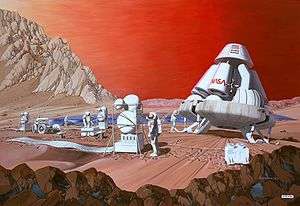
(1989 painting by Les Bossinas of Lewis Research Center for NASA)
In response to a presidential initiative, NASA made a study of a project for human lunar- and Mars exploration as a proposed follow-on to the International Space Station. This resulted in a report, called the 90-day study,[54] in which the agency proposed a long-term plan consisting of completing the Space Station as "a critical next step in all our space endeavors," returning to the Moon and establishing a permanent base, and then sending astronauts to Mars. This report was widely criticized as too elaborate and expensive, and all funding for human exploration beyond Earth orbit was canceled by Congress.[55]
Mars Direct (early 1990s)
Because of the greater distance, the Mars mission would be much more risky and expensive than past Moon flights. Supplies and fuel would have to be prepared for a 2-3 year round trip and the spacecraft would need at least partial shielding from ionizing radiation. A 1990 paper by Robert Zubrin and David A. Baker, then of Martin Marietta, proposed reducing the mission mass (and hence the cost) by using in situ resource utilization to manufacture propellant from the Martian Atmosphere.[56][57] This proposal drew on concepts developed by the former "Case for Mars" conference series. Over the next decade, Zubrin developed it into a mission concept, Mars Direct, which he presented in a book, The Case for Mars (1996). The mission is advocated by the Mars Society, which Zubrin founded in 1998, as practical and affordable.
International Space University (1991)
In 1991 in Toulouse, France, the International Space University studied an international human Mars mission.[58] They proposed a crew of 8 traveling to Mars in a nuclear-powered vessel with artificial gravity provided by rotation.[58] On the surface, 40 tonne habitats pressurized to 10 psi (69 kPa) were powered by a 40 kW photovoltaic array.[58]
NASA Design reference missions (1990s)
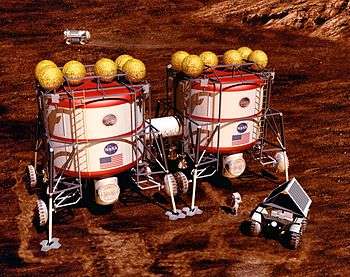
In the 1990s NASA developed several conceptual level human Mars exploration architectures. One of these was NASA Design reference mission 3.0 (DRM 3.0) to stimulate further thought and concept development.
Selected other US/NASA studies (1988–2009):[59]
- 1988 "Mars Expedition"
- 1989 "Mars Evolution"
- 1990 "90-Day Study"
- 1991 "Synthesis Group"
- 1995 "DRM 1"
- 1997 "DRM 3"[60]
- 1998 "DRM 4"
- 1999 "Dual Landers"
21st century
.jpg)
NASA Design reference missions (2000+)
The NASA Mars Design Reference Missions consisted of a series of conceptual design studies for human Mars missions, continued in the 21st century Selected other US/NASA plans (1988–2009):[59]
- 2000 SERT (SSP)
- 2001 DPT/NEXT
- 2002 NEP Art. Gravity
- 2009 DRA 5[61]
MARPOST (2000–2005)
The Mars Piloted Orbital Station (or MARPOST) is a Russian proposed crewed orbital mission to Mars, using a nuclear reactor to run an electric rocket engine. Proposed in October 2000 as the next step for Russia in space along with participation in the International Space Station, a 30-volume draft project for MARPOST was confirmed as of 2005.[62] Design for the ship was proposed to be ready in 2012, and the ship itself in 2021.[63]
ESA Aurora programme (2001+)
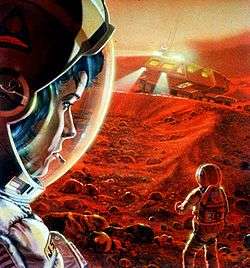
In 2001, the European Space Agency laid out a long-term vision of sending a human mission to Mars in 2033.[64] The project's proposed timeline would begin with robotic exploration, a proof of concept simulation of sustaining humans on Mars, and eventually a crewed mission. Objections from the participating nations of ESA and other delays have put the timeline into question, and currently ExoMars, delivered an orbiter to Mars in 2016, have come to fruition.
ESA/Russia plan (2002)
Another proposal for a joint ESA mission with Russia is based on two spacecraft being sent to Mars, one carrying a six-person crew and the other the expedition's supplies. The mission would take about 440 days to complete with three astronauts visiting the surface of the planet for a period of two months. The entire project would cost $20 billion and Russia would contribute 30% of these funds.[65]
USA Vision for Space Exploration (2004)
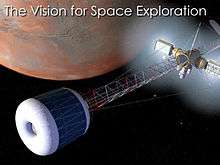
On 14 January 2004, George W. Bush announced the Vision for Space Exploration, an initiative of crewed space exploration. It included developing preliminary plans for a lunar outpost by 2012[66] and establishing an outpost by 2020. By 2005, precursor missions that would help develop the needed technology during the 2010s were tentatively outlined.[67] On 24 September 2007, Michael Griffin, then NASA Administrator, hinted that NASA would be able to launch a human mission to Mars by 2037.[68] The needed funds were to be generated by diverting $11 billion[69] from space science missions to the vision for human exploration.
NASA has also discussed plans to launch Mars missions from the Moon to reduce traveling costs.[70]
Mars Society Germany – European Mars Mission (EMM) (2005)
The Mars Society Germany proposed a crewed Mars mission using several launches of an improved heavy-lift version of the Ariane 5. Roughly 5 launches would be required to send a crew of 5 on a 1200 days mission, with a payload of 120,000 kg (260,000 lb). Total project was estimated to cost 10 to 15 billion Euros.[71]
China National Space Administration (CNSA) (2006)
Sun Laiyan, administrator of the China National Space Administration, said on July 20, 2006 that China would start deep space exploration focusing on Mars over the next five years, during the Eleventh Five-Year Plan (2006–2010) Program period.[72] The first uncrewed Mars exploration program could take place between 2014–2033, followed by a crewed phase in 2040–2060 in which crew members would land on Mars and return home.[73] The Mars 500 study of 2011 prepared for this crewed mission.
Mars to Stay (2006)
The idea of a one-way trip to Mars has been proposed several times. In 1988, space activist Bruce Mackenzie proposed a one-way trip to Mars in a presentation at the International Space Development Conference,[74] arguing that the mission could be done with less difficulty and expense without a return to Earth. In 2006, former NASA engineer James C. McLane III proposed a scheme to initially colonize Mars via a one-way trip by only one human. Papers discussing this concept appeared in The Space Review,[75] Harper's Magazine,[76] SEARCH Magazine[77] and The New York Times.[78]
NASA Design Reference Mission 5.0 (2007)
NASA released initial details of the latest version conceptual level human Mars exploration architecture in this presentation. The study further developed concepts developed in previous NASA DRM and updated it to more current launchers and technology.
Martian Frontier (2007–2011)
Mars 500, the longest high fidelity spaceflight simulation, ran from 2007 to 2011 in Russia and was an experiment to assess the feasibility of crewed missions to Mars.[79]
NASA Design Reference Mission Architecture 5.0 (2009)
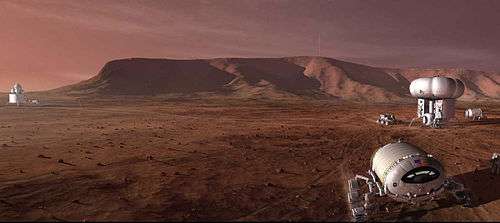
NASA released an updated version of NASA DRM 5.0 in early 2009, featuring use of the Ares V launcher, Orion CEV, and updated mission planning. In this document.[80]
NASA Austere Human Missions to Mars (2009)
Extrapolated from the DRMA 5.0, plans for a crewed Mars expedition with chemical propulsion. Austere Human Missions to Mars
Mars orbit by the mid-2030s (2010)
In a major space policy speech at Kennedy Space Center on 15 April 2010, Barack Obama predicted a crewed Mars mission to orbit the planet by the mid-2030s, followed by a landing. This proposal was mostly supported by Congress, which approved cancelling Project Constellation in favor of a 2025 Asteroid Redirect Mission and orbiting Mars in the 2030s.[81] The Asteroid Redirect Mission was cancelled in June 2017 and "closed out" in September of the same year.
Russian mission proposals (2011)
A number of Mars mission concepts and proposals have been put forth by Russian scientists. Stated dates were for a launch sometime between 2016 and 2020. The Mars probe would carry a crew of four to five cosmonauts, who would spend close to two years in space.
In late 2011, Russian and European space agencies successfully completed the ground-based MARS-500.[82] The biomedical experiment simulating crewed flight to Mars was completed in Russia in July 2000.[83]
2-4-2 concept (2011–2012)
In 2012, Jean-Marc Salotti published a new proposal for a crewed Mars mission. The '2-4-2' concept is based on a reduction of the crew size to 2 astronauts and the duplication of the entire mission. There are 2 astronauts in each space vehicle, there are 4 on the surface of Mars and there are 2 once again in each return vehicle. If one set of hardware runs into trouble, there are 2 astronauts ready to help the 2 others (2 for 2). This architecture simplifies the entry, descent and landing procedures by reducing the size of the landing vehicles. It also avoids the assembly of huge vehicles in LEO. The author claims that his proposal is much cheaper than the NASA reference mission without compromising the risks and can be undertaken before 2030.[84][85]
Boeing Conceptual Space Vehicle Architecture (2012)
In 2012, a conceptual architecture was published by Boeing, United Launch Alliance, and RAL Space in Britain, laying out a possible design for a crewed Mars mission. Components of the architecture include various spacecraft for the Earth-to-Mars journey, landing, and surface stay as well as return. Some features include several uncrewed cargo landers assembled into a base on the surface of Mars. The crew would land at this base in the "Mars Personnel Lander", which could also take them back into Mars orbit. The design for the crewed interplanetary spacecraft included artificial gravity and an artificial magnetic field for radiation protection. Overall, the architecture was modular to allow for incremental R&D.[86]
Mars One (2012-2019)
In 2012, a Dutch entrepreneur group began raising funds for a human Mars base to be established in 2023.[87] The mission was intended to be primarily a one-way trip to Mars. Astronaut applications were invited from the public all over the world, for a fee.
The initial concept included an orbiter and small robotic lander in 2018, followed by a rover in 2020, and the base components in 2024.[87] The first crew of four astronauts were to land on Mars in 2025. Then, every two years, a new crew of four would arrive. Financing was intended to come from selling the broadcasting rights of the entire training and of the flight as a reality television show, and that money would be used to contract for all hardware and launch services. In April 2015, Mars One's CEO Bas Lansdorp admitted that their 12-year plan for landing humans on Mars by 2027 is "mostly fiction".[88] The company went bankrupt in January 2019.[89]
Inspiration Mars Foundation (2013)
In 2013, the Inspiration Mars Foundation founded by Dennis Tito revealed plans of a crewed mission to fly by Mars in 2018 with support from NASA.[90][91] NASA refused to fund the mission.
Boeing Affordable Mission (2014)
On December 2, 2014, NASA's Advanced Human Exploration Systems and Operations Mission Director Jason Crusan and Deputy Associate Administrator for Programs James Reuthner announced tentative support for the Boeing "Affordable Mars Mission Design" including radiation shielding, centrifugal artificial gravity, in-transit consumable resupply, and a lander which can return.[92][93] Reuthner suggested that if adequate funding was forthcoming, the proposed mission would be expected in the early 2030s.[94]
NASA Moon to Mars (2017-)

On October 8, 2015, NASA published its strategy for human exploration and colonization of Mars. The concept operates through three distinct phases leading up to fully sustained colonization.[95]
The first stage, already underway, is the "Earth Reliant" phase. This phase continues using the International Space Station until 2024; validating deep space technologies and studying the effects of long duration space missions on the human body.
The second stage, "Proving Ground," moves away from Earth reliance and ventures into cislunar space for most of its tasks. The proposed Lunar Gateway would test deep space habitation facilities, and validate capabilities required for human exploration of Mars.
Finally, phase three is the transition to independence from Earth resources. The "Earth Independent" phase includes long term missions on the lunar surface with surface habitats that only require routine maintenance, and the harvesting of Martian resources for fuel, water, and building materials. NASA is still aiming for human missions to Mars in the 2030s, though Earth independence could take decades longer.[96]
In November 2015, Administrator Bolden of NASA reaffirmed the goal of sending humans to Mars.[97] He laid out 2030 as the date of a crewed surface landing, and noted that planned 2020 Mars rover would support the human mission.[97]
In March 2019, Vice President Mike Pence declared "American Astronauts will walk on the Moon again before the end of 2024, "by any means necessary"."[98] This reportedly prompted NASA to accelerate their plans to return to the Moon's surface by 2024. NASA says it will use the Artemis lunar program in combination with the Lunar Gateway as stepping stones to make great scientific strides "to take the next giant leap - sending astronauts to Mars".[99]
SpaceX Mars transportation infrastructure (2016-)
Since 2016, SpaceX publicly proposed a plan to begin the colonization of Mars by developing a high-capacity transportation infrastructure.
The ITS launch vehicle design was a large reusable booster topped by a spaceship or a tanker for in-orbit refueling.[100] The aspirational objective is to advance the technology and infrastructure such that the first humans to Mars could potentially depart as early as 2024.[101]
On 29 September 2017, Elon Musk announced an updated vehicle design for the Mars mission at the International Astronautical Congress. The replacement vehicle for this mission was called BFR (Big Falcon Rocket) until 2018, when it was renamed "Starship".[102] Starship will provide the capability for on-orbit activity like satellite delivery, servicing the International Space Station, Moon missions, as well as Mars missions. There are two phases for the first human mission to Mars via Starship:
- In 2022, at least 2 Starship cargo vehicles will land on Mars.
- They will confirm water resources and identify hazards.
- They will place power, mining and life support infrastructure for future missions.
- In 2024, 2 Starship crew vehicles will take the first people to Mars.
- 2 Starship cargo vehicles will bring more equipment and supplies.
- They will place a propellant production plant.
- They will build up a base to prepare for expansion.
Mars Base Camp (2016)
Mars Base Camp (MBC) is a US spacecraft concept that proposes to send astronauts to Mars orbit as early as 2028. The vehicle concept, developed by Lockheed Martin,[103] would utilize both future and heritage technology as well as the Orion spacecraft built by NASA.
Deep Space Transport (2017)
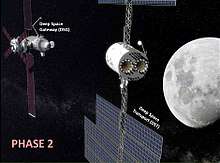
The 'Deep Space Transport (DST), also called Mars Transit Vehicle,[104] is a crewed interplanetary spacecraft concept by NASA to support science exploration missions to Mars of up to 1,000 days.[105][106][107] It would be composed of two elements: an Orion capsule and a propelled habitation module.[108] As of April 2018, the DST is still a concept to be studied, and NASA has not officially proposed the project in an annual U.S. federal government budget cycle.[109][110]
The DST vehicle would depart and return from the Lunar Gateway to be serviced and reused for a new Mars mission.[106][111][112]
Current intentions by nations and space agencies
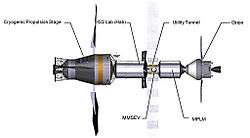
A number of nations and organizations have long-term intentions to send humans to Mars.
- The United States has several robotic missions currently exploring Mars, with a sample-return planned for the future. The Orion Multi-Purpose Crew Vehicle (MPCV) is intended to serve as the launch/splashdown crew delivery vehicle, with a Deep Space Habitat module providing additional living-space for the 16-month-long journey. The first crewed Mars Mission, which would include sending astronauts to Mars, orbiting Mars, and a return to Earth, is proposed for the 2030s.[1][113][114][115] Technology development for US government missions to Mars is underway, but there is no well-funded approach to bring the conceptual project to completion with human landings on Mars by the mid-2030s, the stated objective.[116] NASA is under presidential orders to land humans on Mars by 2033, and NASA-funded engineers are studying a way to build potential human habitats there by producing bricks from pressurized Martian soil.[117]
- The European Space Agency has a long-term goal to send humans but has not yet built a crewed spacecraft. It has sent robotic probes like ExoMars in 2016 and plans to send the next probe in 2022.
- Indian Space Research Organisation successfully placed an uncrewed Mars Orbiter Mission (also called Mangalyaan) satellite in Mars orbit in 2014.[118] ISRO plans a larger follow-up mission called Mangalyaan 2 between 2024 and 2026.[119][120] This mission will likely consist of a lander and a Mars rover.[121][122] No plans for an Indian human mission to Mars have been made public.
- Japan has sent one robotic mission to Mars in 1998, the Nozomi, but it failed to achieve Mars orbit. JAXA has proposed a rover mission called MELOS for an engineering demonstration of precision landing, and to look for possible biosignatures on Mars in 2020 or 2022. No plans for a Japanese human mission to Mars have been made public.
- China's first attempted mission to Mars, the Yinghuo-1 space probe, was lost with Russia's sample return mission to Phobos, Fobos-Grunt in 2011–2012. China plans to develop and launch an orbiter, lander and rover to Mars in July or August 2020[123][124] with a Long March 5 heavy lift rocket.[125][126][127]
- Russia plans to send humans in the 2040–2045 timeframe.[128]
Technological innovations and hurdles


Significant technological hurdles need to be overcome for human spaceflight to Mars.
Entry into the thin and shallow Martian atmosphere will pose significant difficulties with re-entry and for a spacecraft of the weight needed to carry humans, along with life support, supplies and other equipment. Should a heat shield be used, it would need to be very large. Retro rockets could be used, but would add significant further weight.
A return mission to Mars will need to land a rocket to carry crew off the surface. Launch requirements mean that this rocket would be significantly smaller than an Earth-to-orbit rocket. Mars-to-orbit launch can also be achieved in single stage. Despite this, landing an ascent rocket on Mars will be difficult. Reentry for a large rocket will be difficult.
In 2014 NASA proposed the Mars Ecopoiesis Test Bed.[130]
- Intravenous fluid
One of the medical supplies that might be needed is a considerable mass of intravenous fluid, which is mainly water but contains other substances so it can be added directly to the human blood stream. If it could be created on the spot from existing water, this would reduce mass requirements. A prototype for this capability was tested on the International Space Station in 2010.[131]
- Breathing gases
While it is possible for humans to breathe pure oxygen, usually additional gases like nitrogen are included in the breathing mix. One possibility is to take in-situ nitrogen and argon from the atmosphere of Mars; however, they are hard to separate from each other.[132] As a result, a Mars habitat may use 40% argon, 40% nitrogen, and 20% oxygen.[132]
An idea for keeping carbon dioxide out of the breathing air is to use re-usable amine bead carbon dioxide scrubbers.[133] While one carbon dioxide scrubber filters the astronaut's air, the other is vented to the Mars atmosphere.[133]
Precursor missions
Some missions may be considered a "Mission to Mars" in their own right, or they may only be one step in a more in-depth program. An example of this is missions to Mars' moons, or flyby missions.
Missions to Deimos or Phobos
Many Mars mission concepts propose precursor missions to the moons of Mars, for example a sample return mission to the Mars moon Phobos – not quite Mars, but perhaps a convenient stepping stone to an eventual Martian surface mission. Lockheed Martin, as part of their "Stepping stones to Mars" project, called the "Red Rocks Project", proposed to explore Mars robotically from Deimos.[53][135][136]
Use of fuel produced from water resources on Phobos or Deimos has also been proposed.
Mars sample return missions
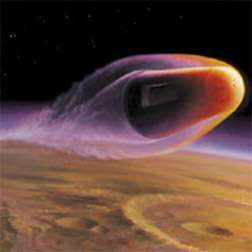
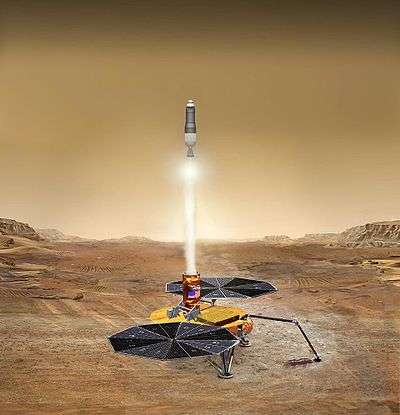
An uncrewed Mars sample return mission (MSR) has sometimes been considered as a precursor to crewed missions to Mars' surface.[137] In 2008, the ESA called a sample return "essential" and said it could bridge the gap between robotic and human missions to Mars.[137] An example of a Mars sample return mission is Sample Collection for Investigation of Mars (SCIM).[138] Mars sample return was the highest priority Flagship Mission proposed for NASA by the Planetary Decadal Survey 2013–2022: The Future of Planetary Science.[139] However, such missions have been hampered by complexity and expense, with one ESA proposal involving no less than five different uncrewed spacecraft.[140]
Sample return plans raise the concern, however remote, that an infectious agent could be brought to Earth.[140] Regardless, a basic set of guidelines for extraterrestrial sample return have been laid out depending on the source of sample (e.g. asteroid, Moon, Mars surface, etc.)[141]
At the dawn of the 21st century, NASA crafted four potential pathways to Mars human missions.[142] Of those four, three included a Mars sample return as a prerequisite to human landing; however one did not.[142]
Currently, the rover Perseverance is equipped with a device that will allow it to pick up and seal samples of rock from Mars, to be returned at a later date by another mission. Perseverance is part of the Mars 2020 mission and is set to launch on top of an Atlas V rocket on 30 July 2020.
Crewed orbital missions
Starting in 2004, NASA scientists have proposed to explore Mars via telepresence from human astronauts in orbit.[143][144]
A similar idea was the proposed "Human Exploration using Real-time Robotic Operations" (HERRO) mission.[145][146]
See also
- Artificial gravity – The use of circular rotational force to mimic gravity
- Delta-v budget
- Exploration of Mars
- Health threat from cosmic rays
- Human spaceflight – Space travel by humans
- Interplanetary spaceflight – Spacecraft travel between planets of the Solar System
- Life on Mars – Scientific assessments on the microbial habitability of Mars
- Mars analog habitat
- Mars Design Reference Mission – Conceptual design studies for crewed missions to Mars
- Martian – Extraterrestrial ethnic group
- Nuclear thermal rocket – Rocket engine that uses a nuclear reactor to generate thrust
- Space medicine – Medical specialty
- Space weather – Branch of space physics and aeronomy
References
- Wall, Mike (27 August 2019). "Astronauts Will Face Many Hazards on a Journey to Mars - NASA is trying to bring the various risks down before launching astronauts to Mars in the 2030s". Space.com. Retrieved 27 August 2019.
- David S. F. Portree, Humans to Mars: Fifty Years of Mission Planning, 1950–2000, NASA Monographs in Aerospace History Series, Number 21, February 2001. Available as NASA SP-2001-4521.
- Page 18-19 in Chapter 3 of David S. F. Portree's Humans to Mars: Fifty Years of Mission Planning, 1950–2000, NASA Monographs in Aerospace History Series, Number 21, February 2001. Available as NASA SP-2001-4521
- Paul D. Wooster; et al. "Mission design options for human Mars missions". CiteSeerX 10.1.1.524.7644. Cite journal requires
|journal=(help) - Page 15-16 in Chapter 3 of David S. F. Portree's Humans to Mars: Fifty Years of Mission Planning, 1950–2000, NASA Monographs in Aerospace History Series, Number 21, February 2001. Available as NASA SP-2001-4521
- "Hohmann transfer orbit diagram". Planetary.org. Retrieved 2018-03-27.
- "Homann Transfers". Jwilson.coe.uga.edu. Retrieved 2018-03-27.
- Werner von Braun, "Popular Science". google.com. Bonnier Corporation. March 1964. Retrieved 12 June 2015.
- "Folta, et al. - FAST MARS TRANSFERS THROUGH ON-ORBIT STAGING. (2012)" (PDF). Usra.edu.
- Matt Williams – Universe Today. "Making A Trip To Mars Cheaper & Easier: The Case For Ballistic Capture". io9. Retrieved 12 June 2015.
- "Crocco". Tdf.it.
- "To Mars by Flyby-Landing Excursion Mode (FLEM) (1966)". Wired.com.
- "Photo-s88_35629". Spaceflight.nasa.gov.
- Diane Vaughan; Bonnie F. James; Michelle M. Murk. "A Comparative Study of Aerocapture Missions with a Mars Destination" (PDF). Ntrs.nasa.gov. Retrieved 16 March 2019.
- Taylor, Fredric (2010). The Scientific Exploration of Mars. Cambridge: Cambridge University Press. p. 306. ISBN 978-0-521-82956-4.
- Kerr, Richard (31 May 2013). "Radiation Will Make Astronauts' Trip to Mars Even Riskier". Science. 340 (6136): 1031. Bibcode:2013Sci...340.1031K. doi:10.1126/science.340.6136.1031. PMID 23723213.
- Zeitlin, C.; et al. (31 May 2013). "Measurements of Energetic Particle Radiation in Transit to Mars on the Mars Science Laboratory" (PDF). Science. 340 (6136): 1080–1084. Bibcode:2013Sci...340.1080Z. doi:10.1126/science.1235989. PMID 23723233.
- Chang, Kenneth (30 May 2013). "Data Point to Radiation Risk for Travelers to Mars". The New York Times. Retrieved 31 May 2013.
- Regis, Ed (September 21, 2015). "Let's Not Move To Mars". New York Times. Retrieved September 22, 2015.
- Scharf, Calib A. (20 January 2020). "Death on Mars - The martian radiation environment is a problem for human explorers that cannot be overstated". Scientific American. Retrieved 20 January 2020.
- "Model calculations of the particle spectrum of the galactic cosmic ray (GCR) environment : Assessment with ACE/CRIS and MARIE measurements". inist.fr. Retrieved 12 June 2015.
- Shiga, David (2009-09-16), "Too much radiation for astronauts to make it to Mars", New Scientist (2726)
- Fong, MD, Kevin (12 February 2014). "The Strange, Deadly Effects Mars Would Have on Your Body". Wired. Retrieved 12 February 2014.
- Gelling, Cristy (June 29, 2013). "Mars trip would deliver big radiation dose; Curiosity instrument confirms expectation of major exposures". Science News. 183 (13): 8. doi:10.1002/scin.5591831304. Retrieved July 8, 2013.
- Scott, Jim (30 September 2017). "Large solar storm sparks global aurora and doubles radiation levels on the martian surface". Phys.org. Retrieved 30 September 2017.
- Mader, T. H.; et al. (2011). "Optic Disc Edema, Globe Flattening, Choroidal Folds, and Hyperopic Shifts Observed in Astronauts after Long-duration Space Flight". Ophthalmology. 118 (10): 2058–2069. doi:10.1016/j.ophtha.2011.06.021. PMID 21849212.
- Puiu, Tibi (November 9, 2011). "Astronauts' vision severely affected during long space missions". Zmescience.com. Retrieved February 9, 2012.
- "Breaking News Videos, Story Video and Show Clips – CNN.com". CNN. Retrieved 12 June 2015.
- Strickland, Ashley (15 November 2019). "Astronauts experienced reverse blood flow and blood clots on the space station, study says". CNN News. Retrieved 22 November 2019.
- Marshall-Goebel, Karina; et al. (13 November 2019). "Assessment of Jugular Venous Blood Flow Stasis and Thrombosis During Spaceflight". JAMA Network Open. 2: e1915011. doi:10.1001/jamanetworkopen.2019.15011. PMC 6902784. PMID 31722025. Retrieved 22 November 2019.
- Horneck, Gerda (2006). "General human health issues for Moon and Mars missions: Results from the HUMEX study". Advances in Space Research. 37: 100–108. doi:10.1016/j.asr.2005.06.077.
- Ehlmann, Bethany L. (2005). "Humans to Mars: A feasibility and cost–benefit analysis". Acta Astronautica. 56: 851–858. doi:10.1016/j.actaastro.2005.01.010.
- Rapp, D. (2005). "Preliminary system analysis of in situ resource utilization for Mars human exploration". 2005 IEEE Aerospace Conference. doi:10.1109/AERO.2005.1559325.
- Queens University Belfast scientist helps NASA Mars project "No-one has yet proved that there is deep groundwater on Mars, but it is plausible as there is certainly surface ice and atmospheric water vapour, so we wouldn't want to contaminate it and make it unusable by the introduction of micro-organisms."
- COSPAR PLANETARY PROTECTION POLICY Archived 2013-03-06 at the Wayback Machine (20 October 2002; As Amended to 24 March 2011)
- "An Astrobiology Strategy for the Exploration of Mars". nap.edu. Retrieved 12 June 2015.
- When Biospheres Collide – a history of NASA's Planetary Protection Programs, Michael Meltzer, May 31, 2012, see Chapter 7, Return to Mars – final section: "Should we do away with human missions to sensitive targets"
- Johnson, James E. "Planetary Protection Knowledge Gaps for Human Extraterrestrial Missions: Goals and Scope." (2015)
- Safe on Mars page 37 "Martian biological contamination may occur if astronauts breathe contaminated dust or if they contact material that is introduced into their habitat. If an astronaut becomes contaminated or infected, it is conceivable that he or she could transmit Martian biological entities or even disease to fellow astronauts, or introduce such entities into the biosphere upon returning to Earth. A contaminated vehicle or item of equipment returned to Earth could also be a source of contamination."
- "Photo-s86_25375". nasa.gov. Retrieved 12 June 2015.
- Annie Platoff, Eyes on the Red Planet: Human Mars Mission Planning, 1952–1970, (1999); available as NASA/CR-2001-2089280 Archived 2010-05-31 at the Wayback Machine (July 2001)
- Wernher von Braun, The Mars Project, University of Illinois Press, Urbana, IL, 1962
- Wernher von Braun, "The Next 20 Years of Interplanetary Exploration," Astronautics & Aeronautics, November 1965, pp 24-34.
- M. Wade, Von Braun Mars Expedition – 1952 Archived 2010-01-16 at the Wayback Machine, in Encyclopedia Astronautica
- "Von Braun Mars Expedition – 1956". astronautix.com. Archived from the original on 16 January 2010. Retrieved 12 June 2015.
- "Article on Von Braun and Walt Disney". History.msfc.nasa.gov. Archived from the original on 11 February 2017. Retrieved 16 March 2019.
- Dyson, George (2002). Project Orion: The Atomic Spaceship 1957-1965. Penguin. ISBN 978-0-140-27732-6.
- Franklin Dixon, "Summary Presentation: Study of a Manned Mars Excursion Module," in Proceedings of the Symposium on Manned Planetary Missions: 1963/1964 Status, NASA TM X-53049 (1964).
- Wernher von Braun, "Manned Mars Landing Presentation to the Space Task Group," presentation materials, August 1969 (referenced by Portree, 2001 op cit.
- Artemis Westenberg (15 July 2012). "Von Braun about Mars.wmv". YouTube.
- Penelope J. Boston, ed., AAS Science and Technology Series Volume 57, Proceedings of the Case for Mars I, 1984 (second printing 1987), ISBN 0-87703-197-5
- Christopher P. McKay, ed., AAS Science and Technology Series Volume 62, Proceedings of the Case for Mars II, 1985 (second printing 1988) 730p. Hard cover: ISBN 0-87703-219-X, Soft cover: ISBN 0-87703-220-3.
- Geoffrey A. Landis, "Footsteps to Mars: an Incremental Approach to Mars Exploration," Journal of the British Interplanetary Society, Vol. 48, pp. 367-342 (1995); presented at Case for Mars V, Boulder CO, 26–29 May 1993; appears in From Imagination to Reality: Mars Exploration Studies, R. Zubrin, ed., AAS Science and Technology Series Volume 91 pp. 339-350 (1997). (text available as Footsteps to Mars pdf file
- NASA, Report of the 90-day study on human exploration of the Moon and Mars, published 11/1989; abstract
- Dwayne Day, "Aiming for Mars, grounded on Earth," The Space Review February 16, 2004 link
- R. M. Zubrin, D. A. Baker and O. Gwynne, "Mars Direct: A Simple, Robust, and Cost Effective Architecture for the Space Exploration Initiative," paper AAS 90-168, in The Case for Mars IV: The International Exploration of Mars, Part I, MISSION STRATEGY & ARCHITECTURES, AAS Science and Technology Series Volume 89, Proceedings of the Case for Mars Conference, ed. Thomas R. Meyer, 1997 (ISBN 0-87703-418-4).
- R. Zubrin and D. A. Baker, "Mars Direct: Humans to the Red Planet by 1999," 41st Congress of the International Astronautical Federation (1990)
- "ISU Manned Mars Mission". 19 April 2014. Archived from the original on 19 April 2014.
- NASA Austere Human Missions to Mars (2009)
- Bret G. Drake, Reference Mission Version 3.0 Addendum to the Human Exploration of Mars: The Reference Mission of the NASA Mars Exploration Study Team, NASA Report NASA/SP—6107–ADD, June 1998 (retrieved 2 October 2015)
- Mars Architecture Steering Group (Bret G. Drake, ed.), Human Exploration of Mars Design Reference Architecture 5.0, NASA/SP–2009–566-ADD (Addendum to NASA/SP–2009–566), July 2009 (accessed 29 Sept. 2015)
- Yury Zaitsev (30 March 2005). "Russia Suggests Manned Martian-Mission Plan". Rianovosty.
- Vladimir Isachenkov (29 October 2009). "Russia Hopes To Fly Humans To Mars With Nuclear Spaceship". The Huffington Post.
- Fred Guterl (2005-11-22). "The Race to Mars". Discover Magazine. Retrieved 2012-08-16.
- "Russia proposes manned Mars mission by 2015" – 8 July 2002 – New Scientist
- "NASA – ESMD". nasa.gov. Retrieved 12 June 2015.
- Andringa, J.M. (2005). "Mars human precursor mission concepts for the decade 2010-2020". 2005 IEEE Aerospace Conference. doi:10.1109/AERO.2005.1559312.
- AFP: NASA aims to put man on Mars by 2037 Archived 2007-12-28 at the Wayback Machine
- "President Bush Announces New Vision for Space Exploration Program". archives.gov. 14 January 2004. Retrieved 12 June 2015.
- The Space Age at 50. National Geographic Magazine, October 2007 issue
- European Mars Mission Encyclopedia Astronautica
- "People's Daily Online -- Roundup: China to develop deep space exploration in five years". English.peopledaily.com.cn.
- "中国嫦娥探月工程进展顺利 进度将有望加快--军事频道-中华网-中国最大职业人士门户". china.com. Archived from the original on 24 February 2012. Retrieved 12 June 2015.
- Bruce Mackenzie, One Way to Mars – a Permanent Settlement on the First Mission," presented at the 1998 International Space Development Conference, May 21–25, Milwaukee WI; Abstract Archived 2013-11-13 at the Wayback Machine
- James C. McLane III, "Spirit of the Lone Eagle": an audacious program for a manned Mars landing, The Space Review July 31, 2006 link
- James C. McLane III, "Starship Trooper," Harper's Magazine November 2006. link (pay subscription required)
- James C. McLane III, "One Way Ticket to Mars," SEARCH Magazine Jan/Feb 2009 link to archived copy
- Krauss, Lawrence M. (31 August 2009). "A One-Way Ticket to Mars". The New York Times. Retrieved 2011-07-20.
- Glenday, Craig (2013). Guinness world records. pp. 140. ISBN 978-1-908843-15-9.
- "Version 5 NASA" (PDF). Ntrs.nasa.gov. January 2009. Retrieved 16 March 2019.
- "Congress Mostly Approves New Direction for NASA". sciencemag.org. Archived from the original on 13 May 2013. Retrieved 12 June 2015.
- Sputnik (14 July 2009). "Mars-500 crew report good health after experiment". rian.ru. Retrieved 12 June 2015.
- "Russia's plans for manned Mars missions". Russianspaceweb.com.
- Jean-Marc Salotti, Acta Astronautica, Volume 69, Issues 5–6, September–October 2011, Pages 266–279.
- Jean-Marc Salotti, Acta Astronautica, Volume 81, Issue 1, December 2012.
- Benton, Mark; Kutter, Bernard; Bamford, Ruth; Bingham, Bob; Todd, Tom; Stafford-Allen, Robin (2012). Conceptual Space Vehicle Architecture for Human Exploration of Mars, with Artificial Gravity and Mini-Magnetosphere Crew Radiation Shield. doi:10.2514/6.2012-5114. ISBN 978-1-60086-940-2.
- "Dutch Group Planning for Mars Settlement by 2023". PCMAG. Retrieved 12 June 2015.
- Mars One Torn To Shreds In MIT Debate. August 21, 2015 by Jonathan O'Callaghan.
- Mars One's ill-fated dream unsurprisingly ends in bankruptcy. J. C. Torres, Slash Gear. 10 February 2019.
- "Space Tourist to Announce Daring Manned Mars Voyage for 2018". WIRED. 20 February 2013. Retrieved 12 June 2015.
- "Millionaire space tourist planning 'historic journey' to Mars in 2018 -". The Space Reporter. Archived from the original on 26 February 2013. Retrieved 12 June 2015.
- K.Klaus, M. L. Raftery and K. E. Post (2014) "An Affordable Mars Mission Design" Archived 2015-05-07 at the Wayback Machine (Houston, Texas: Boeing Co.)
- M. L. Raftery (May 14, 2014) "Mission to Mars in Six (not so easy) Pieces" (Houston, Texas: Boeing Co.)
- NASA (December 2, 2014) "NASA’s Journey to Mars News Briefing" NASA TV
- Mahoney, Erin. "NASA Releases Plan Outlining Next Steps in the Journey to Mars". NASA. Retrieved 2015-10-12.
- "NASA's Journey To Mars: Pioneering Next Steps in Space Exploration" (PDF). Nasa.gov. NASA. October 8, 2015. Retrieved October 10, 2015.
- "NASA Chief: We're Closer to Sending Humans on Mars Than Ever Before". Marsdaily.com.
- Chang, Kenneth (2019-03-26). "The Trump Administration Wants Astronauts on Moon by 2024. But What's the Plan?". The New York Times. ISSN 0362-4331. Retrieved 2019-04-29.
- "NASA: Moon to Mars". NASA. Retrieved 2019-04-29.
- Boyle, Alan (2016-10-23). "SpaceX's Elon Musk geeks out over Mars interplanetary transport plan on Reddit". GeekWire. Retrieved 2016-10-24.
- Foust, Jeff (2016-10-10). "Can Elon Musk get to Mars?". SpaceNews. Retrieved 2016-10-12.
- Musk, Elon (2018-11-20). "Elon Musk on Twitter". Retrieved 2019-10-19.
- "Mars Base Camp". Lockheedmartin.com.
- Human Exploration and Operations Mission Directorate - Architecture Status. (PDF) Jim Free. NASA. March 28, 2017.
- Finally, some details about how NASA actually plans to get to Mars. Eric Berger, ARS Technica. March 28, 2017.
- NASA Unveils the Keys to Getting Astronauts to Mars and Beyond. Neel V. Patel, The Inverse. April 4, 2017.
- Deep Space Transport approaches the Deep Space Gateway. The Planetary Society.
- Deep Space Gateway -Enabling Missions to Mars — Shakedown Cruise Simulating Key Segments of Mars Orbital Mission. Mars Study Capability Team (2018). Michelle Rucker, John Connolly. NASA.
- Cislunar station gets thumbs up, new name in President’s budget request. Philip Sloss, NASA Spaceflight. March 16, 2018.
- NASA evaluates EM-2 launch options for Deep Space Gateway PPE. Philip Sloss, NASA Spaceflight. December 4, 2017.
- Kathryn Hambleton. "Deep Space Gateway to Open Opportunities for Distant Destinations". NASA. Retrieved March 31, 2017.
- Robyn Gatens, Jason Crusan. "Cislunar Habitation & Environmental Control & Life Support System" (PDF). NASA. Retrieved March 31, 2017.
- "Nasa's Orion spacecraft prepares for launch in first step towards manned Mars mission". The Washington Post. Retrieved 2014-12-03.
- "Twitter feed of NASA". Twitter. Retrieved 2014-12-02.
- "NASA's Orion Flight Test and the Journey to Mars". NASA website. Retrieved 2014-12-01.
- Berger, Eric (2016-10-12). "Why Obama's "giant leap to Mars" is more of a bunny hop right now". Ars Technica. Retrieved 2016-10-12.
- Johnston, Ian. "'Incredibly brave’ Mars colonists could live in red-brick houses, say engineers", The Independent (April 27, 2017).
- "India celebrates Mars mission 'cheaper than a movie'". Telegraph.co.uk. Retrieved 24 September 2014.
- "Second mission to Mars may be by 2020: ISRO chief K Radhakrishnan". The Economic Times. Press Trust of India. 12 November 2014. Retrieved 12 November 2014.
- Dodhiya, K. A. (4 January 2015). "Chandrayaan-II in full progress: Isro ex-chief". The Asian Age. Archived from the original on 14 February 2015.
- "India plans second Mars mission in 2018". CNN-IBN. Indo-Asian News Service. 29 October 2014. Retrieved 30 October 2014.
- "ISRO's Mangalyaan-2 Mission to launch in 2018". NIT Sparrows. 2014. Archived from the original on 14 February 2015. Retrieved 14 February 2015.
- "China shows first images of Mars rover, aims for 2020 mission". Reuters. Retrieved 24 August 2016.
- "Interview with Zhang Rongqiao, the man behind China's mission to Mars". Youtube. Retrieved 24 August 2016.
China Central Television
- Jones, Andrew (22 February 2016). "China is racing to make the 2020 launch window to Mars". GBTimes. Retrieved 2016-02-22.
- Berger, Eric (22 February 2016). "China pressing ahead with orbiter and lander mission to Mars". ARS Technica. Retrieved 2016-02-23.
- Lu, Shen (4 November 2016). "China says it plans to land rover on Mars in 2020". CNN News. Retrieved 2016-02-23.
- Пилотируемый полет на Марс будет возможен после 2040 года - Роскосмос. Versii.com (in Russian). Retrieved 22 August 2014.
- Rainey, Kristine (7 August 2015). "Crew Members Sample Leafy Greens Grown on Space Station". Nasa.gov.
- Hall, Loura (2017-03-24). "Mars Ecopoiesis Test Bed". NASA. Retrieved 2018-03-05.
- "A Solution for Medical Needs and Cramped Quarters in Space IVGEN Undergoes Lifetime Testing in Preparation For Future Missions". NASA. Retrieved 12 June 2015.
- "The Caves of Mars – Martian Air Breathing Mice". highmars.org. Archived from the original on 24 July 2007. Retrieved 12 June 2015.
- "Suiting Up for the Red Planet". Ieee.org.
- Larry Page Deep Space Exploration – Stepping Stones builds up to "Red Rocks : Explore Mars from Deimos"
- "One Possible Small Step Toward Mars Landing: A Martian Moon". Space.com. Retrieved 12 June 2015.
- esa. "Mars Sample Return: bridging robotic and human exploration". Esa.int.
- Jones, S.M.; et al. (2008). "Ground Truth From Mars (2008) – Mars Sample Return at 6 Kilometers per Second: Practical, Low Cost, Low Risk, and Ready" (PDF). USRA. Retrieved September 30, 2012.
- "Science Strategy – NASA Solar System Exploration". NASA Solar System Exploration. Archived from the original on 2011-07-21. Retrieved 2015-11-03.
- "Mars Sample Return". Esa.int.
- "Archived copy" (PDF). Archived from the original (PDF) on 2015-11-17. Retrieved 2015-11-05.CS1 maint: archived copy as title (link)
- "Next On Mars". Spacedaily.com.
- Landis, G.A. (2008). "Teleoperation from Mars Orbit: A Proposal for Human Exploration". Acta Astronautica. 62 (1): 59–65. Bibcode:2008AcAau..62...59L. doi:10.1016/j.actaastro.2006.12.049.; presented as paper IAC-04-IAA.3.7.2.05, 55th International Astronautical Federation Congress, Vancouver BC, Oct. 4-8 2004.
- M. L. Lupisella, "Human Mars Mission Contamination Issues", Science and the Human Exploration of Mars, January 11–12, 2001, NASA Goddard Space Flight Center, Greenbelt, MD. LPI Contribution No. 1089. (accessed 11/15/2012)
- George R. Schmidt, Geoffrey A. Landis, and Steven R. Oleson NASA Glenn Research Center, Cleveland, Ohio, 44135 HERRO Missions to Mars and Venus using Telerobotic Surface Exploration from Orbit Archived 2013-05-13 at the Wayback Machine 48th AIAA Aerospace Sciences Meeting Including the New Horizons Forum and Aerospace Exposition 4–7 January 2010, Orlando, Florida
- HERRO TeleRobotic Exploration of Mars, Geoffrey Landis, Mars Society 2010 4 part YouTube Video
Further reading
External links
| Wikimedia Commons has media related to Human missions to Mars. |
- Human Exploration of Mars: The Reference Mission Design Reference Mission 1.0
- Reference Mission Version 3.0, Addedum to Human Exploration of Mars Design Reference Mission 3.0
- Mars Expeditions & Flybys & Selected Flybys List of most crewed mission projects to Mars
- a longer bibliography can be found in the bibliography of Portree's book, available in pdf format from NASA.